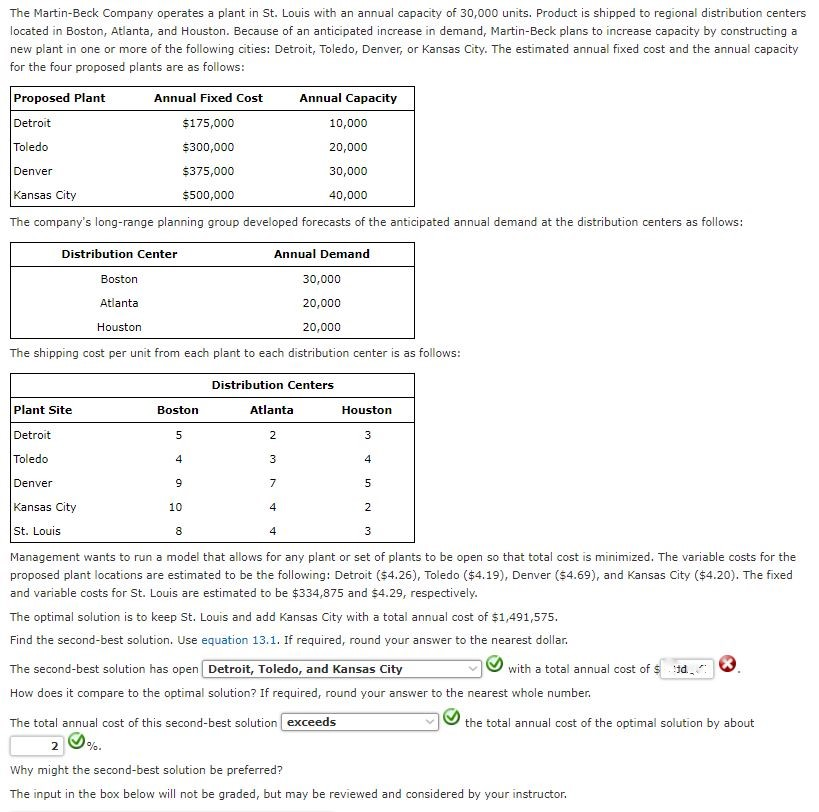
The Martin-Beck Company operates a plant in St. Louis with an annual capacity of 30,000 units. Product is shipped to regional distribution centers located in Boston, Atlanta, and Houston. Because of an anticipated increase in demand, Martin-Beck plans to increase capacity by constructing a new plant in one or more of the following cities: Detroit, Toledo, Denver, or Kansas City. The estimated annual fixed cost and the annual capacity for the four proposed plants are as follows: Proposed Plant Annual Fixed Cost Annual Capacity Detroit $175,000 10,000 Toledo $300,000 20,000 Denver $375,000 30,000 Kansas City $500,000 40,000 The company's long-range planning group developed forecasts of the anticipated annual demand at the distribution centers as follows: Distribution Center Annual Demand Boston 30,000 Atlanta 20,000 Houston 20,000 The shipping cost per unit from each plant to each distribution center is as follows: Distribution Centers Plant Site Boston Atlanta Houston Detroit 5 3 N Toledo 4 3 4 Denver N 9 5 Kansas City 10 4 2 St. Louis 8 4 3 Management wants to run a model that allows for any plant or set of plants to be open so that total cost is minimized. The variable costs for the proposed plant locations are estimated to be the following: Detroit ($4.26), Toledo ($4.19), Denver (54.69), and Kansas City ($4.20). The fixed and variable costs for St. Louis are estimated to be $334,875 and 54.29, respectively. The optimal solution is to keep St. Louis and add Kansas City with a total annual cost of $1,491,575. Find the second-best solution. Use equation 13.1. If required, round your answer to the nearest dollar. The second-best solution has open Detroit, Toledo, and Kansas City with a total annual cost of $ :1d. How does it compare to the optimal solution? If required, round your answer to the nearest whole number. The total annual cost of this second-best solution exceeds the total annual cost of the optimal solution by about 2 %. Why might the second-best solution be preferred? The input in the box below will not be graded, but may be reviewed and considered by your instructor. The Martin-Beck Company operates a plant in St. Louis with an annual capacity of 30,000 units. Product is shipped to regional distribution centers located in Boston, Atlanta, and Houston. Because of an anticipated increase in demand, Martin-Beck plans to increase capacity by constructing a new plant in one or more of the following cities: Detroit, Toledo, Denver, or Kansas City. The estimated annual fixed cost and the annual capacity for the four proposed plants are as follows: Proposed Plant Annual Fixed Cost Annual Capacity Detroit $175,000 10,000 Toledo $300,000 20,000 Denver $375,000 30,000 Kansas City $500,000 40,000 The company's long-range planning group developed forecasts of the anticipated annual demand at the distribution centers as follows: Distribution Center Annual Demand Boston 30,000 Atlanta 20,000 Houston 20,000 The shipping cost per unit from each plant to each distribution center is as follows: Distribution Centers Plant Site Boston Atlanta Houston Detroit 5 3 N Toledo 4 3 4 Denver N 9 5 Kansas City 10 4 2 St. Louis 8 4 3 Management wants to run a model that allows for any plant or set of plants to be open so that total cost is minimized. The variable costs for the proposed plant locations are estimated to be the following: Detroit ($4.26), Toledo ($4.19), Denver (54.69), and Kansas City ($4.20). The fixed and variable costs for St. Louis are estimated to be $334,875 and 54.29, respectively. The optimal solution is to keep St. Louis and add Kansas City with a total annual cost of $1,491,575. Find the second-best solution. Use equation 13.1. If required, round your answer to the nearest dollar. The second-best solution has open Detroit, Toledo, and Kansas City with a total annual cost of $ :1d. How does it compare to the optimal solution? If required, round your answer to the nearest whole number. The total annual cost of this second-best solution exceeds the total annual cost of the optimal solution by about 2 %. Why might the second-best solution be preferred? The input in the box below will not be graded, but may be reviewed and considered by your instructor







